Related Research Articles

Spacecraft propulsion is any method used to accelerate spacecraft and artificial satellites. In-space propulsion exclusively deals with propulsion systems used in the vacuum of space and should not be confused with space launch or atmospheric entry.
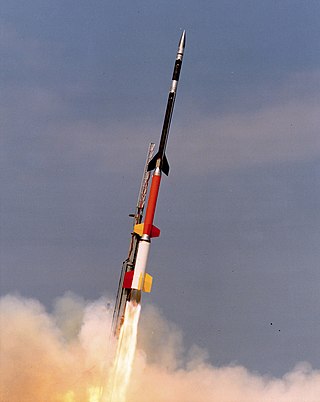
A sounding rocket or rocketsonde, sometimes called a research rocket or a suborbital rocket, is an instrument-carrying rocket designed to take measurements and perform scientific experiments during its sub-orbital flight. The rockets are used to launch instruments from 48 to 145 km above the surface of the Earth, the altitude generally between weather balloons and satellites; the maximum altitude for balloons is about 40 km and the minimum for satellites is approximately 121 km. Certain sounding rockets have an apogee between 1,000 and 1,500 km, such as the Black Brant X and XII, which is the maximum apogee of their class. For certain purposes Sounding Rockets may be flown to altitudes as high as 3,000 kilometers to allow observing times of around 40 minutes to provide geophysical observations of the magnetosphere, ionosphere, thermosphere and mesosphere. Sounding rockets have been used for the examination of atmospheric nuclear tests by revealing the passage of the shock wave through the atmosphere. In more recent times Sounding Rockets have been used for other nuclear weapons research. Sounding rockets often use military surplus rocket motors. NASA routinely flies the Terrier Mk 70 boosted Improved Orion, lifting 270–450-kg (600–1,000-pound) payloads into the exoatmospheric region between 97 and 201 km.

The Brazilian Space Agency is the civilian authority in Brazil responsible for the country's space program. It operates a spaceport at Alcântara, and a rocket launch site at Barreira do Inferno. It is the largest and most prominent space agency in Latin America.

Alliant Techsystems Inc. (ATK) was an American aerospace and arms manufacturer headquartered in Arlington County, Virginia. The company operated across 22 states, Puerto Rico, and internationally. ATK revenue in fiscal year 2014 was about US$4.8 billion.
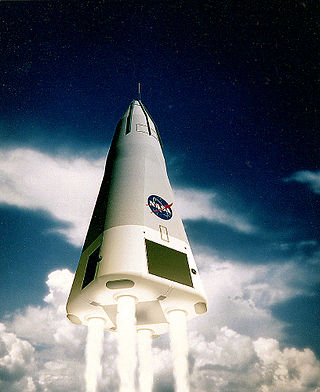
The DC-X, short for Delta Clipper or Delta Clipper Experimental, was an uncrewed prototype of a reusable single-stage-to-orbit launch vehicle built by McDonnell Douglas in conjunction with the United States Department of Defense's Strategic Defense Initiative Organization (SDIO) from 1991 to 1993. Starting 1994 until 1995, testing continued through funding of the US civil space agency NASA. In 1996, the DC-X technology was completely transferred to NASA, which upgraded the design for improved performance to create the DC-XA. After a test flight of DC-XA in 1996 resulted in a fire, the project was canceled. Despite its cancellation, the program inspired later reusable launch systems. Michael D. Griffin has since praised the program as "government R&D at its finest."

The Pacific Spaceport Complex – Alaska (PSCA), formerly known as the Kodiak Launch Complex (KLC), is a dual-use commercial and military spaceport for sub-orbital and orbital launch vehicles. The facility is owned and operated by the Alaska Aerospace Corporation, a corporation owned by the Government of Alaska, and is located on Kodiak Island in Alaska.

The Korea Aerospace Research Institute, established in 1989, is the aeronautics and space agency of South Korea. Its main laboratories are located in Daejeon, in the Daedeok Science Town. KARI's vision is to continue building upon indigenous launch capabilities, strengthen national safety and public service, industrialize satellite information and applications technology, explore the Moon, and develop environmentally-friendly and highly-efficient cutting-edge aircraft and core aerospace technology. Current projects include the KSLV-2 launcher. Past projects include the 1999 Arirang-1 satellite. The agency was founded in 1989. Prior to South Korea's entry into the Institute for Advanced Engineering (IAE) in 1992, it focused primarily on aerospace technology. As of May 2024, KARI is an affiliated research institute of the Korea AeroSpace Administration.

The China Aerospace Science and Technology Corporation (CASC) is a main contractor for the Chinese space program. It is state-owned and has subsidiaries which design, develop and manufacture a range of spacecraft, launch vehicles, and ground equipment. It also has a division for strategic and tactical missile systems.
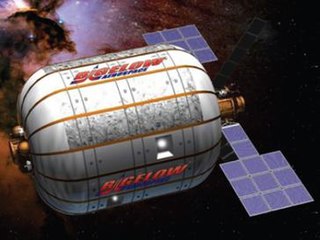
The B330 was an inflatable space habitat privately developed by Bigelow Aerospace from 2010 until 2020. The design was evolved from NASA's TransHab habitat concept. B330 was to have 330 cubic meters (12,000 cu ft) of internal volume, hence its numeric designation.

FalconSAT is the United States Air Force Academy's (USAFA) small satellite engineering program. Satellites are designed, built, tested, and operated by Academy cadets. The project is administered by the USAFA Space Systems Research Center under the direction of the Department of Astronautics. Most of the cadets who work on the project are pursuing a bachelor of science degree in astronautical engineering, although students from other disciplines join the project.
UP Aerospace, Inc. is a private spaceflight corporation headquartered in Denver, Colorado. UP Aerospace provides sub-orbital transportation for corporate, military and educational payloads, via their SpaceLoft XL sounding rocket launch vehicles.

The National Institute of Aeronautics and Space was the Indonesian government's space agency. It was established on 27 November 1963, by former Indonesian president Sukarno, after one year's existence of a previous, informal space agency organization. LAPAN is responsible for long-term civilian and military aerospace research.
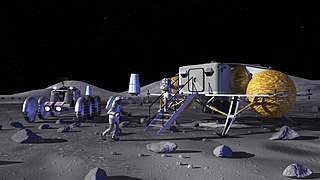
The National Aeronautics and Space Administration (NASA) has proposed several concept moonbases for achieving a permanent presence of humans on the Moon since the late 1950s. Research and exploration of the Moon have been a large focus of the organization since the Apollo program. NASA's peak budget was in 1964–1965, when it comprised 4% of all federal spending in service of the Apollo Moon landing project. Though lunar landings since the conclusion of the Apollo program in 1972 have ceased, interest in establishing a permanent habitation on the lunar surface or beyond low Earth orbit has remained steady. Recently, renewed interest in lunar landing has led to increased funding and project planning. NASA requested an increase in the 2020 budget of $1.6 billion, in order to make another crewed mission to the Moon under the Artemis program by 2025, followed by a sustained presence on the Moon by 2028. A crew was selected for the planned crewed mission, Artemis II, in April 2023.

Air-launch-to-orbit (ALTO) is the method of launching smaller rockets at altitude from a heavier conventional horizontal-takeoff aircraft, to carry satellites to low Earth orbit. It is a follow-on development of air launches of experimental aircraft that began in the late 1940s. This method, when employed for orbital payload insertion, presents significant advantages over conventional vertical rocket launches, particularly because of the reduced mass, thrust, cost of the rocket, geographical factors, and natural disasters.
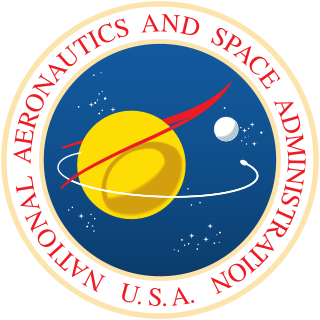
The National Aeronautics and Space Administration is an independent agency of the US federal government responsible for the United States' civil space program, aeronautics research and space research. Established in 1958, it succeeded the National Advisory Committee for Aeronautics (NACA) to give the US space development effort a distinct civilian orientation, emphasizing peaceful applications in space science. It has since led most of America's space exploration programs, including Project Mercury, Project Gemini, the 1968–1972 Apollo Moon landing missions, the Skylab space station, and the Space Shuttle. Currently, NASA supports the International Space Station (ISS) along with the Commercial Crew Program, and oversees the development of the Orion spacecraft and the Space Launch System for the lunar Artemis program.

Orbiting Vehicle or OV, originally designated SATAR, comprised five disparate series of standardized American satellites operated by the US Air Force, launched between 1965 and 1971. Forty seven satellites were built, of which forty three were launched and thirty seven reached orbit. With the exception of the OV3 series and OV4-3, they were launched as secondary payloads, using excess space on other missions. This resulted in extremely low launch costs and short proposal-to-orbit times. Typically, OV satellites carried scientific and/or technological experiments, 184 being successfully orbited through the lifespan of the program.

Space research is scientific study carried out in outer space, and by studying outer space. From the use of space technology to the observable universe, space research is a wide research field. Earth science, materials science, biology, medicine, and physics all apply to the space research environment. The term includes scientific payloads at any altitude from deep space to low Earth orbit, extended to include sounding rocket research in the upper atmosphere, and high-altitude balloons.
SpaceWorks Enterprises, Inc. (SEI) is an aerospace engineering company based in Atlanta, Georgia, United States that specializes in the design, assessment, hardware prototyping and flight demonstration of advanced space concepts for both government and commercial customers.

Orbiting Vehicle 2-1, the first satellite of the second series of the United States Air Force's Orbiting Vehicle program, was an American life science research satellite. Its purpose was to determine the extent of the threat posed to astronauts by the Van Allen radiation belts. Launched 15 October 1965, the mission resulted in failure when the upper stage of OV2-1's Titan IIIC booster broke up.
References
- ↑ "ITEC". Archived from the original on April 26, 2009. Retrieved 2010-06-17.
- ↑ "Mountjoy observatory" . Retrieved 2010-06-17.
- ↑ "Delaware Aerospace Academy" . Retrieved 2010-06-17.
- ↑ "Rockets for Delaware" . Retrieved 2010-06-17.